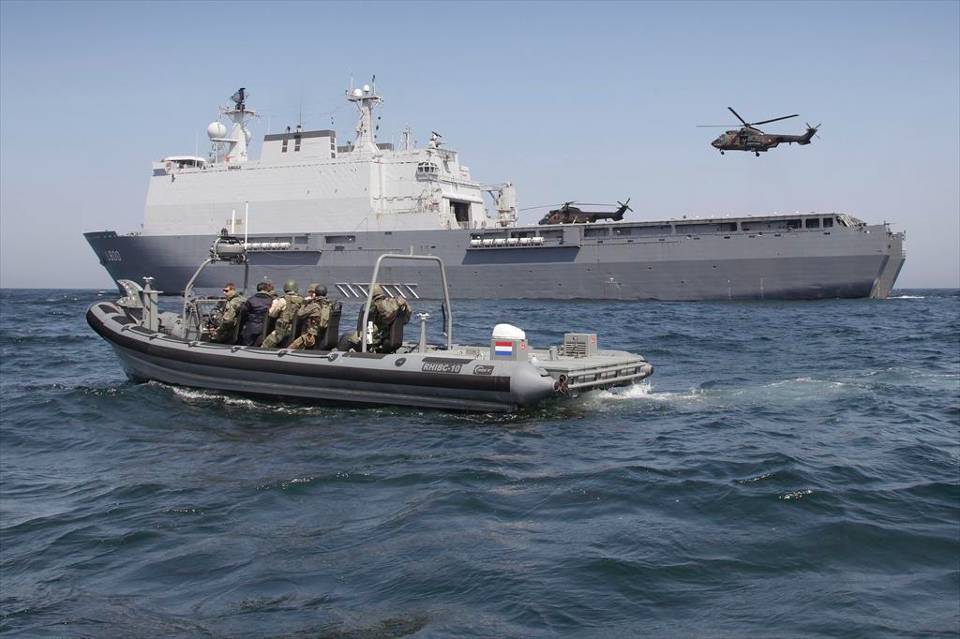Starting in 2032, the Royal Navy will have a new ship class consisting of six new ships: amphibious transport ships. The six are to replace the four Holland-class patrol ships and the two LPDs Zr.Ms. Rotterdam and Zr.Ms. Johan de Witt.
The two current LPDs, Zr.Ms. Rotterdam and Zr.Ms. Johan de Witt, will reach the end of their service lives in 2028 and 2032, respectively. The current OPVs reach the end of their service life between 2035 and 2038. The Navy may commission the first new amphibious transport ship in 2032. The sixth and final one should enter service in 2037 and be operationally deployable beginning in 2038. For the oldest ship to be replaced, Zr.Ms. Rotterdam, 2032 is later than the planned end-of-life date. That stands at 2028. Defense is investigating whether the ship can continue to sail for longer and what measures are needed. The intention is to also take a ship out of service each time a ship is commissioned.
Flexibility in operational deployment
The amphibious transport ships meet the replacement needs for both classes of ships. Replacing LPDs and OPVs with a single class of new Amphibious Transport Ships provides the Royal Navy with greater flexibility in operational deployment and it provides greater efficiency. By building six such ships, different tasks can be done by different ships. An Amphibious Transport Ship can also be used as a station ship in the Caribbean. The station ship then immediately has amphibious capabilities.
The Defense Department explicitly mentions that amphibious transport ships, unlike patrol ships, must also be suitable for the highest violence spectrum.
Renewed craft
The amphibious transport ships will operate with a series of new and refurbished craft: the new Littoral Assault Craft (LAC) for personnel and the Littoral Craft Mobility (LCM) for personnel and materiel. These will be delivered in 2026 – 2030. The heavy LCU landing craft are being modernized now, with the A letter of replacement of these craft due in 2027. The Marine Corps will also receive new vehicles. These will have to be transported with the above landing craft. These are, on the one hand, tracked vehicles to be replaced through the Future Littoral All-Terrain Mobility Band Vagn project and the Landrovers to be replaced by new patrol vehicles.
Early involvement of Dutch industry
As with the ‘Replacement LC Frigates’ project, the Department of Defense wants to involve the Dutch Maritime Manufacturing Industry at an early stage, earlier and more intensively than before, in the construction and design of the ships. This is part of the new approach of ‘industry-enhancing procurement’ in which Defense envisions a partnership with the sector that involves not only the construction of naval ships but also infrastructure, personnel, innovation, knowledge development and maintenance. With this approach, Defense aims to broadly strengthen the Dutch defense industry and thus contribute to greater European strategic autonomy. In doing so, Defense intends to engage the Dutch maritime sector under Article 346 TFEU. This project falls into the 1 to 2.5 billion euro category.
International cooperation
The Netherlands and the United Kingdom have worked together for amphibious operations and marines for more than 50 years in the UK/NL Amphibious Force. On June 30, 2023, the two countries signed a Statement of Intent at ministerial level on cooperation in replacing their large amphibious ships. The Netherlands and the UK do not build identical ships, but ensure the interoperability of their equipment. Cooperation is possible on multiple systems of both countries’ new ships.
The B letter is expected in 2025 and the D letter in 2027.
Limited risks
The risks with this project are viewed defense as limited. There is a risk that there is insufficient personnel capacity within Defense to complete the acquisition in time, given the other major naval investment projects. There is also a risk that the desired interoperability with the United Kingdom will lead to higher costs. With regard to personnel capacity, Defense will carefully allocate it among the various projects and will resort to hiring if necessary. A risk reserve is part of the project budget.
Download the letter